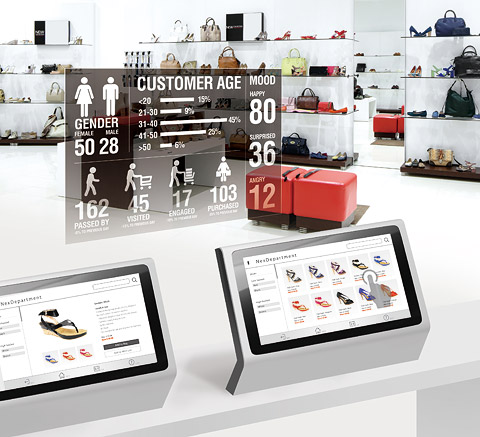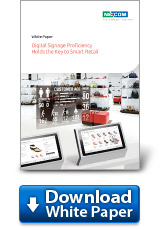Digital Signage Proficiency Holds the Key to Smart Retail

The driving forces of cloud technology, big data analytics and the Internet of Things (IoT) have sparked a new wave of innovations for the retail industry. For retailers, the transformation to Retail 4.0 requires the integration of omni-channel retailing and online-to-offline (O2O) commerce. One of the key technologies to unlocking this transformation is digital signage.
In the past, digital signage only provided one-way information delivery. With the advancement in image processing and IoT sensor technologies, digital signage today now provides smart, interactive technologies to engage customers in new exciting ways. The rise of more smarter, connected digital signage is bringing unprecedented opportunities for the retail market, helping retailers to become early adopters of Retail 4.0.
Looking back at the retail evolution, the earliest form of retailing was open shelf stores, which then evolved into modern self-service supermarkets that marked the beginning of retail chains like Walmart and Tesco and the transition from Retail 1.0 to Retail 2.0. In Retail 3.0, the retail industry was introduced to e-commerce and gave rise to big online retailers like Amazon and eBay. Now in Retail 4.0, the retail industry has taken a path to O2O commerce, where physical retailers provide offline customers with interactive online shopping experiences, reshaping the value of brick-and-mortar stores.
Jenny Shern, Assistant Vice President of NEXCOM's Interactive Signage Platform Business Unit (ISP BU), believes that interactive digital signage will become the catalyst to the Retail 4.0 transformation. Communicating information with vivid visual aids, digital signage is the most ideal point of interest to deliver sales-oriented content. Furthermore, with the integration of interactive technology and improved image processing, digital signage can display tailored messages to a specific customer, and simultaneously engage the customer with virtual interactions to increase product interest and dwell time. This will enhance the shopping experience, allowing customers to learn more about the product, increase purchase intent, and ultimately improve sales.
The Heart of Building Smart Retail Solutions
Shern further points out that digital signage can integrate add-on software to create smart retail solutions that respond to the three major trends in Retail 4.0: omni-channel commerce, smart retail system and big data analytics.
For omni-channel commerce, connected O2O kiosks can help physical retailers to integrate multiple online channels to provide real-time tailored advertising, product searching and checkout services, reinvigorating customer interactions and shopping experiences. O2O kiosks can also integrate augmented reality (AR) technology and serve as a virtual product assistant to provide more in-depth information. Additionally, O2O kiosks can offer in-store digital services such as product label scanning, automatic checkout and customer call support to reduce wait times and improve service levels. When not in use, O2O kiosks can also display promotions or entertainment content.
For smart retail systems, in-store digital signage with image processing and tracking technology can visually see, sense or even hear the presence of nearby customers, and display dynamic content based on demographics. Take NEXCOM's smart retail solution for instance, which consists of the NDiS B535 digital signage player and exclusive in-house software PowerDigiS. The bundled solution integrates technologies such as high resolution camera, facial recognition, radio-frequency identification (RFID), electronic shelf label (ESL) and beacon notifications. It also integrates Microsoft Azure cloud service platform for data analysis of viewer demographics such as age, gender and other attributes to display content tailored to the interest of a target audience group.
Boosting In-store Traffic with Big Data Analytics
Shern states that there is an increasingly fierce competition between businesses in the retail industry. Retailers are relentlessly finding ways to optimize retail management efficiencies and customer shopping experiences to increase in-store traffic and sales while reducing operating costs. By utilizing retail analytics, retailers can analyze customer buying behavior, effectiveness of product placements, in-store traffic patterns and other parameters, allowing retailers to revise strategies and adjust resources accordingly to improve operations. To provide the image processing performance required for such analytics, NEXCOM's high-performance digital signage player NDiS B426 features discrete NVIDIA graphics which can simultaneously analyze video streams of four IP cameras.
Nelson Chang, Product Division Manager of NEXCOM's ISP BU, further adds that for retail analytics software, NEXCOM has collaborated closely with various regional partners to study and survey the needs and preferences of different markets to accurately provide the user interface and analytics algorithms relevant to each different sector. Customizations to fulfill special requirements are also available upon request.
























